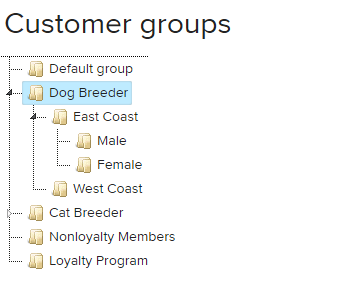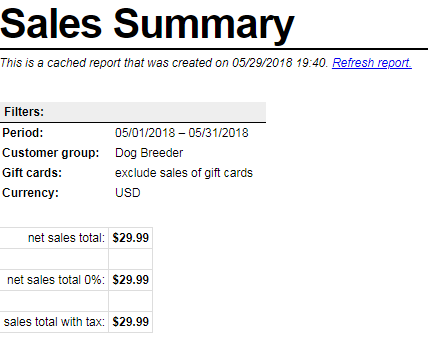This is where retail customer segmentation comes in.
Simply put, customer segmentation is when retailers arrange their broad customer base into smaller subgroups – often with the help of a next-generation POS system. Retailers pick and choose relevant groups and add them to their POS database, which continuously updates itself as shoppers make purchases or interact with that store’s shopkeepers and customer service professionals.
What is a customer group?
A customer group is a subset of similar customers. When businesses begin retail customer segmentation, individuals are sorted into groups based on gender, geographical location, commonly purchased goods, or other defining features. If you’re wondering how to start segmenting customers, begin by identifying broad categories that apply to large groups of shoppers. Once you’ve established overarching groups, you can break those down into smaller, more specific categories. It’s okay if your customer groups see overlap, but too much overlap can hinder your data analysis.Retail POS like Erply give you the tools to create customer groups for unique pricing, reward point allocation, and data analysis. Retail customer segmentation helps you identify purchasing trends across multiple demographics and create stronger, more successful marketing strategies based on that data.

Read further to learn the many ways customer segmentation can be used in retail.
Segmentation Aims to Individualize Customers
Customer segmentation makes marketing, product development, and even customer service more effective by helping retailers gain further insight into specific groupings within their customer base. Remember that not every shopper has the same expectations from a company. Without customer segmentation, businesses often struggle to meet these expectations when its customers are grouped into a collective, rather than sorted into segments that reflect them more accurately. Collecting Smarter Data That Improves Your Business
Another benefit of segmentation is that it helps retailers get a better understanding of their performance. Metrics relating to sales, marketing campaigns, and incentive programs can all be broken down into segments based on the customer’s transactional data. Even better, most cloud-based POS solutions automatically record and update a customer’s transaction data every time they make a purchase, and then sync that information across all retail locations and connected devices.Erply keeps track of each customer’s interaction with your stores. Every purchase, return, and sales order are recorded and can be generated into reports for easy analysis. Certain items in your store may sell significantly quicker than others. You can user Erply to run a report and identify which customers are more inclined to buy those items. If one customer group is underperforming, you can create promotions targeted towards those shoppers. Erply’s retail customer segmentation gives you actionable data to better inform your sales strategies.

Retailers can use this information in a number of different ways, including determining which demographic or buyer persona is their ideal customer. This can be done by seeing which customer segments:
- Have the largest transaction size per-visit.
- Are the most profitable for the company over an extended period of time.
- Have the highest transaction frequency.
- Are more likely to have one-time shoppers and reoccurring shoppers.

Enhancing Marketing Campaigns with Customer Segments
One of the biggest advantages of customer segmentation
is how it enhances marketing campaigns. By tracking customers in groups, retailers can look at a number of different variables to help them determine the best way to attract new customers, build brand loyalty, and create awareness around specific products.
The seven most popular customer segments used in retail marketing are:
Acquisition
: How did the buyer become a customer? This knowledge helps businesses sharpen their onboarding strategy by looking at whether individual customers learned about the retailer through online or offline channels. Categories can be further divided into social media promotions, word-of-mouth referrals, random walk-ins, and more.
First purchase:
Companies look at the first purchase new customers make to help make predictions about shoppers’ future activities. Segmenting this data is helpful when creating buyer personas, the level of attachment the customer has to a store, and their price sensitivity.
Devices used:
Similar to the acquisition segment, device types look at how customers engage with retailers online. It can be subdivided into a number of different categories, such as if your site is more commonly viewed through a web browser or a mobile device. This helps retailers learn more about which types of device users are more likely to frequent stores and are easier to engage with.
Location
: Companies can look at factors like customers’ postal codes and distance from the closest store to make a number of predictions. This retail customer segmentation data lets retailers look at where customers live in relation to their store and competitors’, as well as look further into various regional shopping trends.
Income levels:
Shoppers’ income levels can be segmented in various ways, including by postal code, state, age, gender, and more. This data can help retailers optimize their email marketing campaigns by advertising specific products to customers based on their income level.
Gender:
Men and women tend to have different needs and shopping patterns, and arranging customers by gender helps businesses look at these patterns and come up with effective marketing tactics. Gender groupings are also helpful when promoting male and female-specific products online.
Age:
Retailers can make a number of predictions about customers based on their age. For example, millennials are more receptive to online marketing strategies, whereas baby boomers may be loyal to a specific brand and are typically more affluent.
The Bottom Line on Customer Segmentation in Retail
When integrated into a well-rounded marketing campaign, retail customer segmentation is a valuable tool for connecting with shoppers from different backgrounds – especially when increasing brand loyalty among existing customers. Along with improving marketing campaigns and enhancing product development, customer segmentation is also a great way to increase customer engagement. Retailers can track a customer’s activity within various groups, which is helpful for determining who’s most receptive to outreach programs, rewards and incentives, and reminders.
Whether you’re a big-name retailer or a mom-and-pop’s store, understanding your market is an important part of running a successful retail store. Retail customer segmentation tools can help you can learn more about specific groupings within your customer base and how you can better reach them – whether it’s through marketing, customer service, promotions or engaging with them in a more personalized manner.